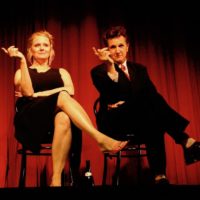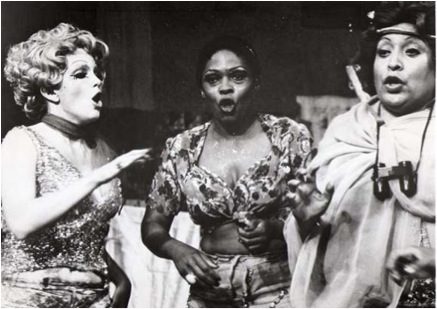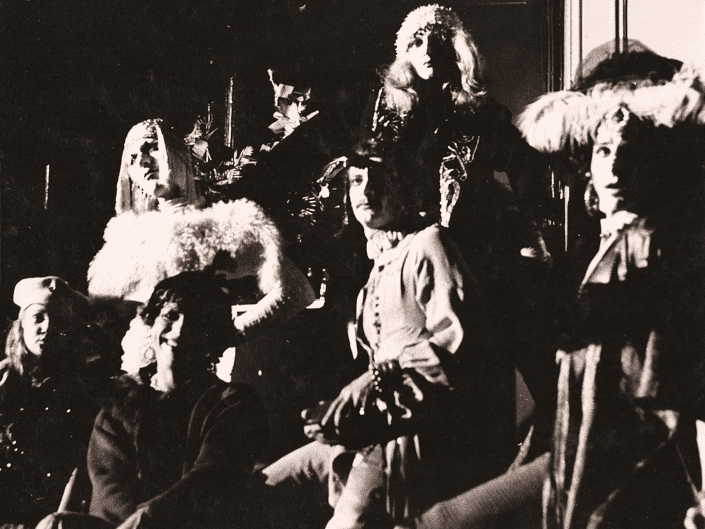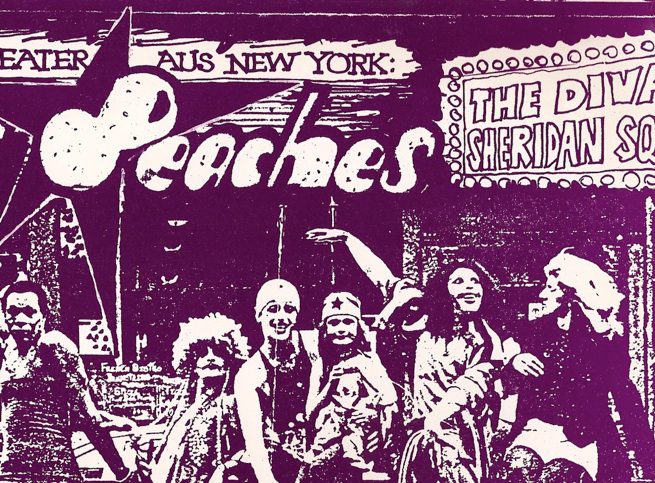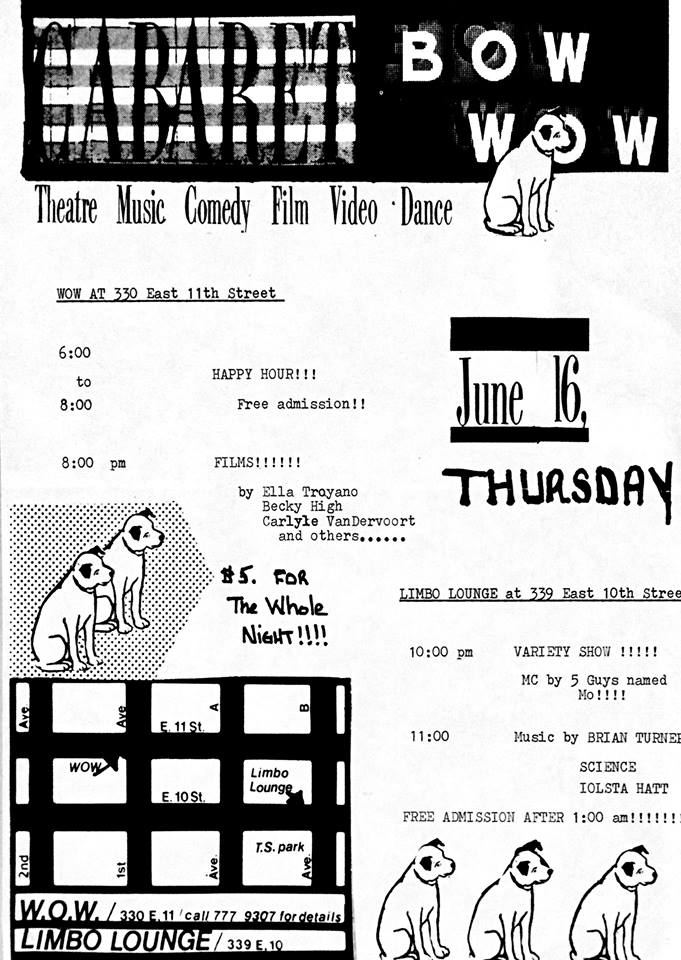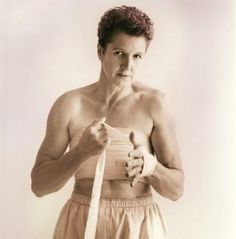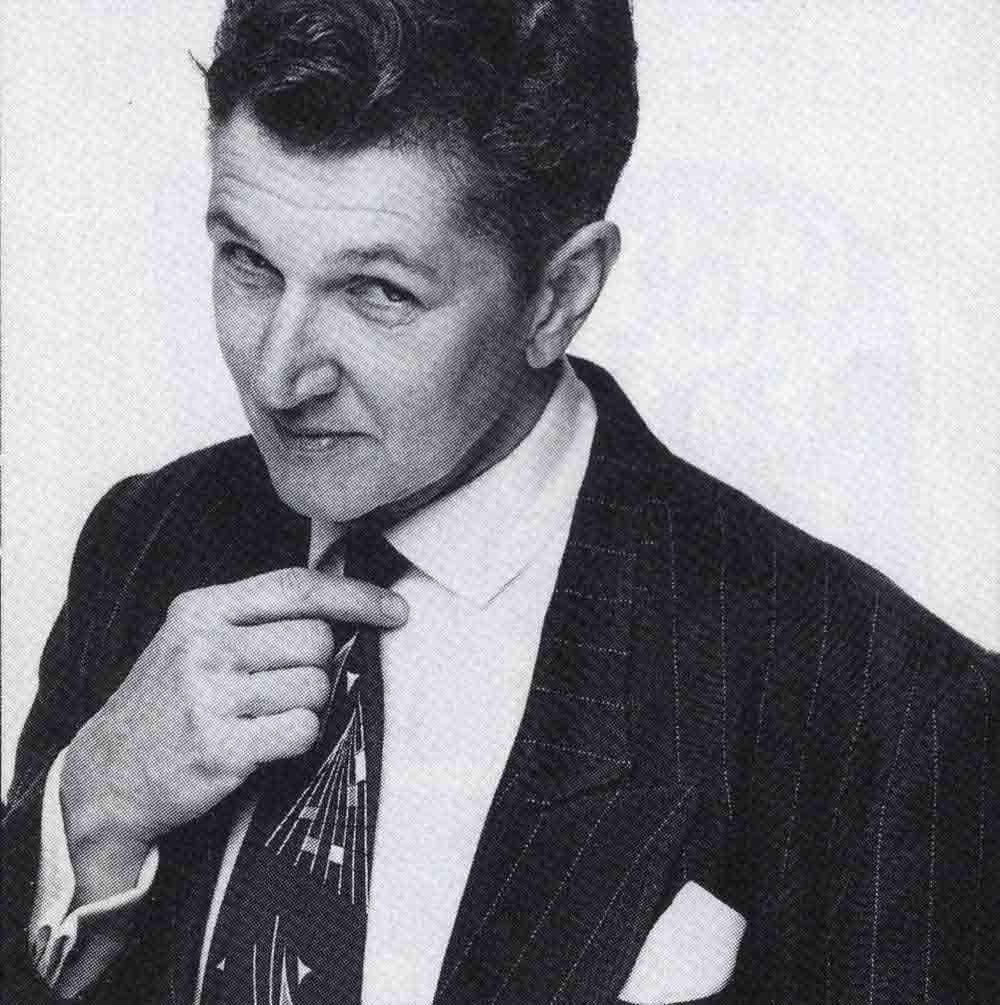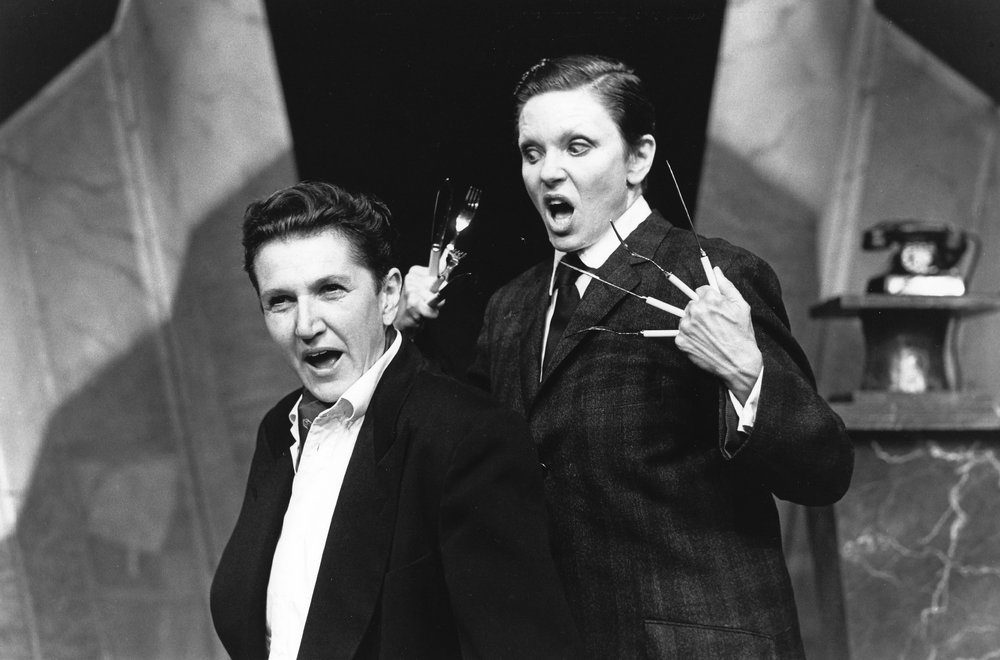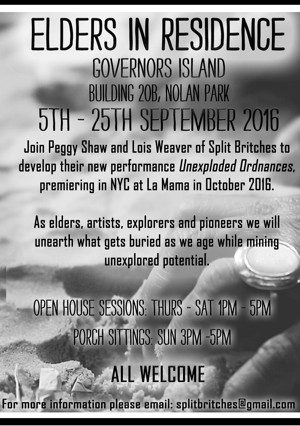A lost set of costumes led to the chance meeting of Lois Weaver and Peggy Shaw in Europe in the 70s, when each was touring with her respective theater troupe. Along with Deb Margolin, they founded Split Britches in New York in 1980. In their own words, Split Britches “straddles the line between performance and theater, exploiting theatricality while exposing the pretense. It is about a community of outsiders, queers, eccentrics.”
The company’s performances have brought together lived experience and fantasy, pushing the boundaries of both. Split Britches has received numerous awards, including a Jane Chamber award and four Obies. In the early 1980s, Weaver and Shaw also helped to establish the WOW Café Theatre, which provided a home base for groundbreaking artists including Holly Hughes, Carmelita Tropicana, Lisa Kron, and Moe Angelos. Still in operation, the WOW Café Theatre remains a vital community space that brings visibility to under-represented identities and experiences, and fosters alternative forms of public conversation.
Shaw and Weaver have also continued to create exciting new work together and separately under the company’s umbrella. They’re currently developing a new performance about aging, anxiety, and how to look forward when the future is uncertain. It’s called Unexploded Ordnances (UXO), and it will premiere at La MaMa this January. We had a chance to meet and talk about their lives and work, and I’m truly honored to share that conversation with you.
***
The Rumpus: Lois, I understand you came to your work via a more traditional route than Peggy’s. Tell me about that.
Lois Weaver: I think I was always an exhibitionist, and I feel like I came to it from that point of view. When I was four, my parents would sit me up on the table and make me sing “How Much is That Doggie in the Window?,” and I liked the audience—I liked the relation to the audience. And I grew up in a working class Southern area where there wasn’t much to do. Socially, the only thing to do was church, so I got involved and that’s where I was first introduced to theater. There were church plays, so I got to be on the stage and people looked at me and I liked that.
Rumpus: Were you also exposed to theater in school?
Weaver: There were little school plays, but it was nothing like dramatic literature or anything anyone would recognize. I did a couple of those and then I got more involved in high school, and on the day I arrived at college I said, “I’m majoring in theater.” It just popped out of my mouth. I didn’t even plan it. I got involved in a fantastic theater program. It was an all women’s college. The program was tiny, but it was run by two extremely fierce professors.
Rumpus: How so?
Weaver: We had to do everything ourselves; build the theater practically because it was in a Home Ec lab. We built the sets, TD’d the shows, directed the shows, acted in the shows, played the men’s parts. I couldn’t have asked for a better training for what I ended up doing.
Rumpus: What were your next steps?
Weaver: This was in the 70s, and towards the end of school I got introduced to experimental theater. At the same time I became a little politicized—which was an isolating experience because no one around me was. My college was a teaching school really, with maybe four thousand women. About half were early education majors, and the other half were PE majors, and then there was this tiny little group who did theater. [Laughs] I always say if I knew then what I know now… but I wasn’t out. So I became my version of a feminist. I got politicized around the Vietnam War, kind of dropped the idea of wanting to do conventional theater, and decided I wanted to become an activist instead.
Rumpus: How did you pursue activism?
Weaver: I moved to Baltimore and started to work at a peace and justice center. There was a great movement there that had been started by The Berrigans. That was quite a learning curve because I’d grown up in a more or less a matriarchal Southern family, gone to an all-female college, and then suddenly was in a male-dominated leftist peace movement where I couldn’t achieve because I was relegated to getting coffee and making Xeroxes. So I started working in a soup kitchen, in a halfway house for mental health patients, all kinds of social activism that led me to the Baltimore Free Theater the first year they were connected to Antioch. They brought in some of my heroes, people who had worked with The Open Theater and Grotowski, and experimental practitioners who’d been working in New York. I started taking classes and edged back into theater when I realized I could put my activism into making performance.
Rumpus: Is that what brought you to New York?
Weaver: I came with a bunch of people from that group. At the time several companies had broken up, so there were a lot of people giving workshops here. I took a lot of them while working in a fish market, then in the public school system as a Special Ed. teacher because I had an education degree. Finally I got hooked up with Muriel Miguel, who was starting Spiderwoman Theater, and suddenly I was in a company of feminist women, talking about our lives, making the work we wanted to make, based on fantasy and desire.
Rumpus: As I understand it, Spiderwoman comes out of Native tradition.
Weaver: When it first started, it was Muriel and several of her friends who were Native women living in the New York area, me, and a couple of other white women. We were working on what Muriel calls “story weaving,” which is based on a Hopi goddess myth. At first, I was thinking, “Why are we talking about these mundane details?” I wouldn’t refer to people by their first names. I wouldn’t refer to my own life story as anything that had value. But they constantly talked in these terms, and it taught me to honor that, to use that, and now it’s something I teach to others.
Rumpus: So it’s not only your lived experience that’s a viable basis for the art you make, but also your fantasies and desires?
Weaver: Yes. When you ask yourself what to make, you also have to ask, What do I really want to make. What’s my fantasy? Do I want to play Juliette? Do I want to be a country western singer? Do I want to be James Dean? And then you build around that.
Rumpus: Peggy, your work is also strongly based on lived experience and fantasy, but you came to this through a completely route.
Shaw: Yes, I had an art teacher in high school who said, “You’re going to college.” At first I said, “No, people in my family don’t go to college. They go to work.” But she said, “Well, you’re going to college and you’re going to be an artist.” So she took me over to Mass. College of Art, and arranged for my entrance, and I went. It opened my mind and my heart in many ways. There were all of these artists around me—free thinkers, queers, women, and people of color—except for the painting department, where I was majoring. They’d have a meeting and tell all of the women to study education because only men become famous painters.
Rumpus: Were you discouraged?
Shaw: Well, yes and no. I was told I could paint as good as the men. I also fell in love with a woman for the first time—her name was Cathy and she was in a ceramics department. My best friend Peter, and this other friend of mine, we had all motorcycles. The three of us all thought we were James Dean, and we were all in love with Cathy. She chose Peter and I thought I was going to die. They moved to New York, so I said to the other James Dean, “Do you want to get married and move to New York?” He said sure. And then they had a kid, so we had a kid. And then I left him a couple of years later because I fell in love with a woman at work. And then I met Hot Peaches.
Rumpus: How did you connect with them?
Shaw: I met them on the street. They were doing drag shows, and I started following them around, eventually making sets for them. One day Jimmy Camicia said, “Let’s go to Europe.” In those days you could stay in your apartment for six months without paying rent, so we all saved up and bought one-way tickets to London.
Rumpus: You brought your kid along with you?
Shaw: Yes. You could take more risks back then. People were kinder. When we got to London we had nowhere to stay, so we went to Hampstead Heath, which was the only place we knew. We were planning to sleep in the park, but a woman came along and said, “I know someone from the People Show and she has an attic.” So I lived in the squat for a couple of years.
Rumpus: Tell more about crossing over from being a set designer to becoming a performer.
Shaw: Well, back then if you were queer there were three things you could do: You could break down, you could be on drugs or alcohol, or you could be quiet. So I was quiet, and so was my kid. But one day Jimmy said, “We need a lesbian in the show so you’re gonna do it at the Oval next week.” I said I didn’t do shows, so he taught me how to smoke marijuana and he made me go to the park and recite poetry. The next week we got to the Oval, to this big room with mirrors all around. He said, “Go in that room. You have ten minutes to write a monologue.” I went into the room and started screaming and yelling. What came out was a monologue made up of all the words people had ever used against me: Dyke! Faggot! Whore! I just started screaming it out. Ten minutes later, I came out of the room and Jimmy asked if I had my monologue. I said, “Yeah.” When I did it at the show, opening night, the audience was really scared of me. Later Jimmy wrote a song called, “Freaked Out Liberated Feministic Altruistic Dyke-Loving Fag Hag Whore Whore Whore.” We all did it in harmony.
Weaver: [Laughs]
Shaw: In New York it wasn’t that overtly political, but in Europe we became a very radical gay cabaret. And my kid was in the show, too. We taught her a song called “Yin and Yang.” (Sings: “Of all the roles I’ve known, and I’ve known some…” ). She was about four years old.
Rumpus: How did you connect with Lois?
Shaw: We got a show in Amsterdam, and we had enough money for me and my kid to get there on the “magic bus,” which was a train, a ferry, and a train, but the rest of the group had to come later. We heard there was another group from New York performing at the same theater as us—Spiderwoman. I took my kid to see them. Afterwards I said, “Wow! Great show! How many of you are gay?” And they were all like, “Uh, no, we’re not gay. There are some bisexuals…”
Rumpus: Right.
Shaw: [Sighs] But then, to make a very long story short, Spiderwoman lost their costumes in Berlin and we were also coming to Berlin. They called and asked to borrow ours, and so we met up there.
Weaver: This was the first time we tried to ship our costumes, but they never arrived. We were all about dressing in rags, with children’s toys tied around our waists, pots and pans, using humor to address various subjects. But we weren’t glamorous by any stretch. And Peggy shows up with this suitcase full of feather boas, and high heels, and push up bras…
Shaw: Because our show was all about being fabulous… the legend of Lola Lamar, the Divas of Sheridan Square—that was the show Jimmy wrote for Marsha P. Johnson.
Weaver: And we were a “feminist” theater company, but we weren’t typical feminists either—in Boston the audience was aghast that we dressing down in these rags, and putting on our makeup after the show.
Shaw: Also, keep in mind that it was not on to be butch then either. I wasn’t welcome in a lot of lesbian bars. The guys in Hot Peaches would tease me that I would get hit on the most in gay bars after our shows.
Rumpus: So, Lois, how did you react to this suitcase full of drag accouterments?
Weaver: We just started putting it on, and we did the show, and we were never the same after that. Every show had some aspect of that appropriation of glamour… for ourselves. We became a different kind of drag queen.
Rumpus: Peggy, how did you bring this into your performance work?
Shaw: Hot Peaches taught me how to perform, and be aggressive, and do cabaret. But I’d do monologues about being butch, and rolling cigarettes, and cowboy stuff, and I’d get booed because I was with a drag group.
Rumpus: Is that why you left Hot Peaches?
Shaw: We had toured for about three years, and we did not have any money, so we came back to New York in 1977. But after connecting with Spiderwoman I just wanted to work with women; I was so hungry to get away from the boys.
Weaver: We both had experiences, things we wanted to say, but sometimes they were at odds with the perceived gay liberation and feminist liberation at the time. So in 1980 we formed Split Britches [along with Deb Margolin].
Rumpus: Tell me about how that also led to the formation of WOW—Women’s One World Festival.
Weaver: The first WOW festival was in 1980. We’d been to festivals in Europe and seeing the ways in which they combined film screenings, and performance, and theater, and dancing, and drinking, and socializing in a way we didn’t have in New York.
Shaw: So we were having a conversation with our friends, Jordi Mark and Pamela Camhe, about starting a festival up here. Across the street from a café where I was sitting was the All-Craft Center. One day I saw three rainbows over their building, so I went inside and introduced myself and asked if we could hold the festival there. They said yes! It seated four hundred people, and it had a bar… it was an incredible speakeasy. Then we traipsed into the Village Voice, told them about the festival, and asked them to cover it. They did!
Weaver: Yes. We decided to do this festival in October and we got the space in maybe May or June. We didn’t have any money, so all summer long we did weekly events to raise money and get people introduced to the idea.
Shaw: We’d sit on St. Mark’s Place—it used to be if you were out there all day, every person you needed to see would go by. We got the volunteers, the lights, the curtains, everything we needed. That’s how we got it together.
Weaver: When it came time for the festival we did crazy things like writing and hand-stamping the press releases, decorating them with glitter…
Shaw: The best advertising we did was to say no man could come without a woman, to guarantee that we’d always have an audience of at least half women. The boys went crazy—how dare women do exactly the same thing they accuse men of doing! Of course we didn’t enforce it.
Weaver: Yes! It was just a camp thing we got from Hot Peaches. In the early days they would charge admission to their shows and if you said you were queer you could pay $3. If not, you had to pay $5.
Shaw: [Laughing] Loads of people came.
Rumpus: How did the festival lead to the WOW Café?
Weaver: It made us realize it was possible. Rents were rising, but in 1983 we managed to get a place for $300 a month. And a lot of little clubs were happening at the same time, like 8. B.C. and Limbo Lounge, so it was kind of a scene.
Shaw: But within the space of two years our rent went up to $5,000.
Weaver: Still, we grew and grew. We always created community for the work while we were making the work. That was always really important to us.
Rumpus: Your work also began to achieve recognition in feminist academic circles.
Shaw: Yes, in the 90s theorists started writing about us. Once this woman came up to me after seeing my solo show, “You’re Just Like My Father,” and asked me how I learned to act and walk like that, “and your hands… “ I was like, “What are you talking about? This is how I walk. These are my hands. They’re like this because I worked all my life, doing construction, painting…” She thought everything I did was put on. I explained to that I learned from Hot Peaches and Spiderwoman to perform from within my own identity and experiences.
Rumpus: Did the attention change the way you perceived your own work, or your identity and experiences?
Weaver: I don’t think so.
Shaw: It made me self-conscious.
Weaver: But we were thrilled for the attention. We could have been completely ignored and invisible. And they also challenged us. I mean sometimes there would be things we would discuss privately in the rehearsal room, like things we wanted to make happen, and then to have them pick up on that in the show. Even if they sometimes talked about it in an indecipherable language, it helped push the work.
Rumpus: Did they get it right most of the time?
Weaver: Often the moment they’d analyze in the most detail was the accident that would happen that night, the thing that had to be solved on impulse because we were performing. But I think it was that moment of realness that I think they were drawn to, not us consciously going “Let’s do X because it will mean Y.”
Rumpus: No—that’s what they do!
Shaw and Weaver: [Laughing] But in theater-based performance, which is what we do, you are always yourself. You can always see the person through the character.
Rumpus: That’s the opposite of other approaches to acting I’ve heard described, for example, the one that holds that the actor should disappear entirely behind the character, should in essence “become” that character.
Weaver: That’s right… in more conventional forms of theater.
Rumpus: In writing, too—for example people who write memoirs, but insist they are works of fiction drawn from the eye rather than experience. But even if you change certain details to “fictionalize” your story, you’re often retaining the truth of what actually happened, how you perceived it, how you felt, etc. It’s a strange sort of obfuscation.
Shaw: And yet we see a lot of people who are now trying to make shows like ours, but sometimes you can see them having studied various things.
Rumpus: I feel like I see that lot with feminist gender performance theory. Also, starting in the 90s, there was a shift in feminist discussions about the meaning of drag. There was a certain moment when drag was embraced as an amplification of the gender performance that takes place in everyday life, almost fetishized to a certain extent. But by the aughts there was a massive evacuation of butch identity. I was teaching at the time, and my young lesbian students would tell me there were no butches left—they’d all come out as trans.
Weaver: We think and talk about that, too. When we started to play theatrically with butch-femme neither of us were particularly living it at the time. Primarily it rooted us to our working-class backgrounds, and it felt familiar to us in that way. But after using it as a theatrical tool, we actually started living it. Then we also detected a move away from butch-centered queerness to trans-centered queerness, and we ended up making a piece about it called “Lust and Comfort.”
Rumpus: Today the discussion has moved into the mainstream with shows like Orange Is the New Black and Transparent. I think that trans visibility is great, and I support it, though it also means I’m more often mistaken for a man.
Shaw: I never pretended to be a man, never wanted to be a man. But I’ve oftentimes been mistaken for a man, and I never had a desire to feminize myself. And because our material comes from our lives, it never occurred to me to change myself in performance.
Rumpus: Yes, but if I’m in a restaurant with my family, and the waitress says to me, “Sir, what will you be having?” my kids will start cracking up because they know mommy isn’t a man. That’s fine but the waitress will likely over-apologize in a way that’s much worse than having mistaken me for a man. And at that point I have to decide if I want to “educate” her, or I just want to move on and get the food on the table before my kids get too fidgety. I wish we could have the conversation but there’s no time or context for that.
Shaw: You know we used to have consciousness-raising—it was every Thursday night. You could think about what you’re doing, think about the world. We don’t have that any more, time and space to explore.
Rumpus: But you’re now in an evolution of your work where there is direct audience engagement—maybe that’s another form of consciousness-raising.
Weaver: We’ve always made work that helps us with the particular challenges we’re facing in the moment. We did that with our very first piece, “Split Britches,” about the untold lives of women in the Blue Ridge Mountains of Virginia in the 1930s. We did it with “Beauty and the Beast” when we were first coming to terms with butch-femme, and understanding binaries. In “Upwardly Mobile Home” we were dealing with the economics of the Thatcher/Reagan era and what it meant for us to be artists when friends of ours were becoming more conventionalized. And “Lust and Comfort” was about our long-term relationship and our community, which was moving away from an identity we understood.
Rumpus: And now in various ways you’re also addressing aging, in Peggy’s “Menopausal Gentleman” and “RUFF,” the show about her stroke, and in your character, Tammy WhyNot, a former famous country music singer turned lesbian performance artist who talks with elders about sexual health.
Weaver: Health, wellbeing, and approaches to aging have become the current mystery in front of us. We’re trying to create a space to wonder, to muse—but not necessarily to opine.
Rumpus: Tell me more about how that contributed to the development of your new show “Unexploded Ordnances (UXO),” in which you work in direct collaboration with the audience.
Weaver: With “UXO” we wanted to allow for conflict within difficult conversations. We started out with an interest in unexploded ordnances being related to unexplored desires, and how that’s relevant particularly to older people. And we were interested in what would happen if we uncovered that. What would be the risk, and also what would be the resource?
Rumpus: I find that people my age are more risk averse than younger people—maybe it’s because we feel we have more to lose. Is the same true for older people?
Weaver: That is our perceived notion about older people, that we’re risk averse, and to a certain point that’s true. But from the people we’ve talked to and encountered on this journey, there seems to be a point on the other side where it doesn’t matter anymore, where people say, “Oh, let’s give that a go!” Maybe they want to play the piano, or take a trip to Morocco. And even if they don’t do it, they do ride that fantasy, they’re willing to see where it takes them. It’s the space of the “could.”
Rumpus: Dr. Strangelove is also one of the inspirations for“UXO.” How is the show related to the idea of a doomsday?
Weaver: The other risk we explore is the unexpressed risk of the tensions that get buried, the things you never talked about, the stuff that keeps you up at night.
Rumpus: Conflicts or tensions that would be more productively resolved if they were openly expressed?
Weaver: Yes, that’s been something that’s come up a lot around public discussions about the Civil War monuments lately. Coincidentally when we had a residency on Governor’s Island to develop the show, and the first unexploded ordnance we encountered was a Civil War cannonball.
Rumpus: I observe that there is a lot of anxiety right now around having difficult conversations, fear that something you say might be a trigger for someone else’s trauma. How do you facilitate or moderate those conversations?
Weaver: In the space of the performance we’ve created a “situation room,” a large round table for public discussion. We want to create a protocol so we can have a way to work through any conflict that might arise. Even when we’ve had an aspect of conflict, and there’s been a little bit, there seems to be an ability to work toward a consensus about the terms of the discussion.
Shaw: People do listen to each other.
Weaver: And we want to put the performance right up against the conversation, hoping that the humor and the performative aspects of our characters, e.g., we do a Conway Twitty and Loretta Lynn song, and Peggy does an Art Carney dance, will help to ameliorate tensions that might arise. Of course another aspect of the show is our determination to put ten or eleven old people on stage and have people see them and listen to them talk. That is something we don’t get to experience every day.
Shaw: We started doing this work because there was nothing out there. We had to write our own truth.
Rumpus: So the idea is to work within the space of the “what if,” to expand the boundaries of possibility. That seems to be the through-line to all the work you’ve made, the way you’ve lived…
Shaw: At certain points in our lives, we just said yes to things.
Weaver: Oh, yes!
***
BONUS MATERIAL
You can see “Unexploded Ordnances (UXO)” at La MaMa Theatre in NYC from January 2–21, 2018 and at the Barbican Centre in London from May 15–19, 2018.
Many of Split Britches’s past performances have been digitally archived at the Hemispheric Digital Institute Library. Lois’s performance practice and history has also been documented and illustrated in The Only Way Home Is Through The Show: Performance Works of Lois Weaver. And Peggy’s book A Menopausal Gentleman, which includes scripts of her solo performances “You’re Just Like My Father,” “Menopausal Gentleman,” “To My Chagrin,” and “Must,” won the 2012 Lambda Literary Award for LBGT Drama.
***
Portrait of Lois © Eva Weiss and portrait of Peggy © Craig Lucas. All other photographs courtesy of Split Britches.
***
This interview has been edited and condensed. If you’d like to recommend someone for “Sound & Vision,” drop Allyson a line here.
